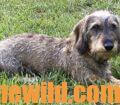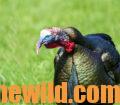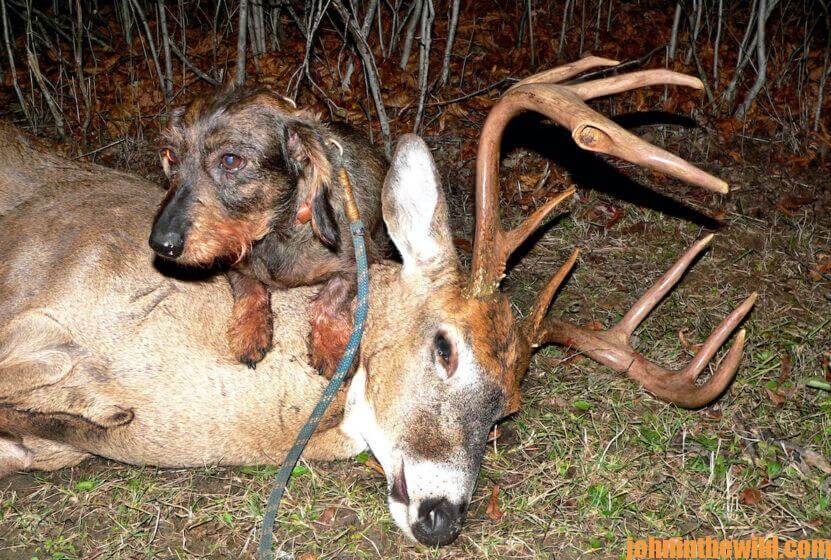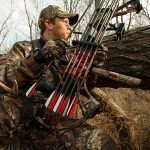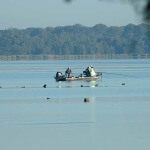Editor’s Note: These dogs were once called blood-trailing dogs, and some are still called that today. After seeing so many dogs following the trails of wounded deer when there was no blood trail, many handlers now refer to these dogs as tracking dogs. They follow the scent of the wounded deer that their interdigital glands between the deer’s toenails secrete. German game managers have been training and using these types of dogs for many years. Much has been learned about how and what the German and European trainers are now using to train trailing dogs. Photo above courtesy of Jolanta Jeanneny.
The Three-Layer System for Training a Deer-Tracking Dog
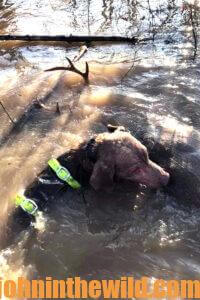 When teaching a dog to track, most people start by dragging a portion of a deer liver on a string through the woods because it has such a strong scent to create a trail for young dogs to follow easily. “Tracking dogs are usually started with following a deer liver at 8-weeks old,” Darren Minor of Maryland, a longtime trainer for tracking and trailing dogs, says. Minor believes in what is called a layering technique for training tracking dogs. “Before we stop using the liver, we start introducing deer blood on the same trail with the liver. Finally, we’ll quit using the liver, and the dog will learn to follow the scent of the blood trail only. As the dog learns to follow the blood trail, the trainer makes the blood trail longer and lets the blood trail age by allowing several hours to pass before the dog is allowed to start following the blood trail. After the dog has proven he can follow a blood trail, we introduce the paste from one or two deer hooves where the interdigital glands are located to the blood trail. There’s a hole between the deer’s toenails where the deer’s interdigital gland produces a pasty substance. The dog not only will follow the blood trail but also the scent left by the interdigital gland. Most trainers today use a commercial deer tracking shoe.
When teaching a dog to track, most people start by dragging a portion of a deer liver on a string through the woods because it has such a strong scent to create a trail for young dogs to follow easily. “Tracking dogs are usually started with following a deer liver at 8-weeks old,” Darren Minor of Maryland, a longtime trainer for tracking and trailing dogs, says. Minor believes in what is called a layering technique for training tracking dogs. “Before we stop using the liver, we start introducing deer blood on the same trail with the liver. Finally, we’ll quit using the liver, and the dog will learn to follow the scent of the blood trail only. As the dog learns to follow the blood trail, the trainer makes the blood trail longer and lets the blood trail age by allowing several hours to pass before the dog is allowed to start following the blood trail. After the dog has proven he can follow a blood trail, we introduce the paste from one or two deer hooves where the interdigital glands are located to the blood trail. There’s a hole between the deer’s toenails where the deer’s interdigital gland produces a pasty substance. The dog not only will follow the blood trail but also the scent left by the interdigital gland. Most trainers today use a commercial deer tracking shoe.
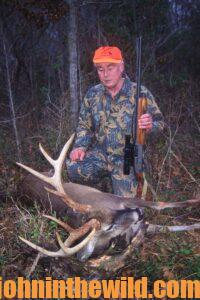 “When I began training dogs, I didn’t have a tracking shoe like most trainers use. So, I’d tie two deer hooves to two, 4-foot-long 1-1/4 inch PVC pipes and shove the dead deer’s legs into those pipes. The hooves that I’d used a screwdriver to get the interdigital gland paste from were at the bottom of the pipes. Next I duct taped the deer’s feet to the pipes. Then I pushed those hooves into the ground along the blood trail the dog was accustomed to following. After the dog learned to work that combination of blood and interdigital gland scent trail, I’d begin to wean the dog off that combination of scents and just have him follow the interdigital gland scent.”
“When I began training dogs, I didn’t have a tracking shoe like most trainers use. So, I’d tie two deer hooves to two, 4-foot-long 1-1/4 inch PVC pipes and shove the dead deer’s legs into those pipes. The hooves that I’d used a screwdriver to get the interdigital gland paste from were at the bottom of the pipes. Next I duct taped the deer’s feet to the pipes. Then I pushed those hooves into the ground along the blood trail the dog was accustomed to following. After the dog learned to work that combination of blood and interdigital gland scent trail, I’d begin to wean the dog off that combination of scents and just have him follow the interdigital gland scent.”
The interdigital gland scent answers the question of how a dog can follow a wounded deer’s trail where there’s no blood on the ground. The 4-foot-long tracking sticks were cumbersome but would lay a scent trail. Minor had joined United Blood Trackers of America (UBT) http://www.unitedbloodtrackers.org/ that also had a Facebook group https://www.facebook.com/unitedbloodtrackers/. The largest group of people who owned and trained tracking dogs participated in that webpage. This organization was started in July, 2005, by a group of expert trackers who included John and Jolanta Jeanneney. John authored the book, “Tracking Dogs for Finding Wounded Deer,” available today at https://www.born-to-track.com/book/order-info.htm and Amazon.. The good news is that anyone can join this organization and learn plenty about tracking dogs, training tracking dogs and everything someone needs to know about tracking dogs.
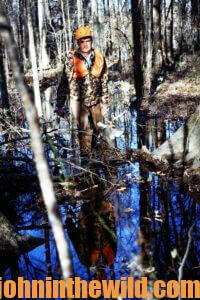 Minor joined the group when he first bought a Wirehaired Dachshund tracking-dog pup he named Fritz that came from a line of deer-tracking dogs. However, Minor knew absolutely nothing about training a tracking dog. “Through Instant Messaging and talking to resource people at the UBT group, I received plenty of information about how to start-off training Fritz. The goal was to train my dog to be able to follow a hoof-track-only scent that was 24-hours old for 1,000 yards. In my opinion, a good tracking dog should be able to track the interdigital gland scent left by a deer’s hoof – if someone has gut shot a deer, and there’s no blood trail to follow. Also, if and when the blood trail runs out, the dog still should be able to follow that wounded deer, until the deer is recovered.”
Minor joined the group when he first bought a Wirehaired Dachshund tracking-dog pup he named Fritz that came from a line of deer-tracking dogs. However, Minor knew absolutely nothing about training a tracking dog. “Through Instant Messaging and talking to resource people at the UBT group, I received plenty of information about how to start-off training Fritz. The goal was to train my dog to be able to follow a hoof-track-only scent that was 24-hours old for 1,000 yards. In my opinion, a good tracking dog should be able to track the interdigital gland scent left by a deer’s hoof – if someone has gut shot a deer, and there’s no blood trail to follow. Also, if and when the blood trail runs out, the dog still should be able to follow that wounded deer, until the deer is recovered.”
A Deer-Tracking Shoe and Where and How to Find It

Minor bought a pair of German-made tracking shoes that the company – Wasgau – made with the creator of the tracking shoe, Walker Saltzman, who trains deer-tracking dogs in Germany. According to
Minor, “The shoes enabled me to bolt a deer’s hoof to the bottom of the rubber shoes that left no human scent. I could wear these shoes out into the woods and leave a trail for a dog to follow. The big advantage to using the tracking shoe was that once you attached the hoof to the bottom of the rubber shoe, you put these shoes on over your boots and could start laying a track through the woods. A bar goes across the deer foot in the tracking shoes that lets the interdigital gland leave a scent as you walk. By using the shoe, you’re hands-free, and you don’t have to use poles and push them into the ground like I once did with one PVC pole in each hand, laying a tr ack. With these German rubber shoes, all I have to do is walk in the woods to leave a track for the dog to follow.
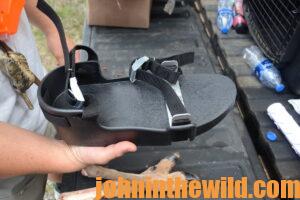
“In 1985, Saltzman had developed this tracking shoe after making many prototypes, and he started producing them. They mainly were sold only in Germany. My partner A.J. Bartlinski and I formed Blood Tracking Dogs of Central Maryland on Facebook https://www.facebook.com/Blood-Tracking-Dogs-LLC-107148454553840/. We started getting calls from all over the United States from people wanting to buy these tracking shoes. When we contacted Wasgau and asked to be the sole distributor for their tracking shoes in the U.S., the company was excited to work with us because they were supplying all the tracking-shoe orders in Europe. Wasgau wanted to have a distributor who would stock the shoes and fill the orders in the U.S., rather than Wasgau handling individual orders from the U.S. If anyone from the U.S. contacted the Wasgau store in Germany wanting deer-tracking shoes, Wasgau contacted me, gave me the person’s name and contact information, and I’d sell them the shoes. We solved a problem for Wasgau, and they solved a problem for us.
 “The official name of our company is Blood Tracking Dogs LLC. The official name of the shoes is the Wasgau Scent Shoe. The shoes retail for less than $200, we send them to your door, and the shoes come with a one-year warranty and pictures to show how to attach the deer hoof to the bottom of the shoe. The shoes are universal in that one size fits all. We started the business in April of 2021. To order the shoes, you can contact Blood Tracking Dogs of Maryland https://www.facebook.com/groups/532052164317392/ on Facebook or http://Bloodtrackingdogsllc.com/, or call me at 443-293-2395.”
“The official name of our company is Blood Tracking Dogs LLC. The official name of the shoes is the Wasgau Scent Shoe. The shoes retail for less than $200, we send them to your door, and the shoes come with a one-year warranty and pictures to show how to attach the deer hoof to the bottom of the shoe. The shoes are universal in that one size fits all. We started the business in April of 2021. To order the shoes, you can contact Blood Tracking Dogs of Maryland https://www.facebook.com/groups/532052164317392/ on Facebook or http://Bloodtrackingdogsllc.com/, or call me at 443-293-2395.”
Only use the feet of deer that have been wounded and have run a good distance. As Darren Minor reports, “You don’t want to use the foot of a deer that has been rifle shot, and the deer has dropped straight to the ground. You want to use the foot from a deer that has been shot and then has run for some time and fallen due to his wound. This wounded deer will produce more of the interdigital paste scent between his toes than the deer that’s not stressed.
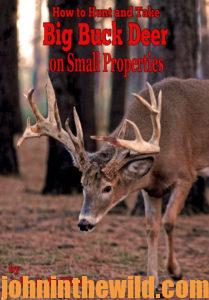 “I also want to get two deer feet from the same deer and use those same deer hooves with my two tracking shoes. I’ve found whether you use the hind or the front hooves of the deer doesn’t seem to matter. When I get deer feet, I freeze them and then thaw them before I use them and put them on the shoes. I don’t pull the paste out of the gland. Some people do take the paste out with a key or a screw driver and rub it on the hoof. The best time to do that is the first time you’re introducing the scent from the interdigital gland to your dog. You’re adding more scent to the bottom of the hoof, which works great for younger dogs. With older dogs, you should be able to take the hooves out of the freezer, thaw them and put them on your shoes. Then an older dog should be able to follow that track.”
“I also want to get two deer feet from the same deer and use those same deer hooves with my two tracking shoes. I’ve found whether you use the hind or the front hooves of the deer doesn’t seem to matter. When I get deer feet, I freeze them and then thaw them before I use them and put them on the shoes. I don’t pull the paste out of the gland. Some people do take the paste out with a key or a screw driver and rub it on the hoof. The best time to do that is the first time you’re introducing the scent from the interdigital gland to your dog. You’re adding more scent to the bottom of the hoof, which works great for younger dogs. With older dogs, you should be able to take the hooves out of the freezer, thaw them and put them on your shoes. Then an older dog should be able to follow that track.”
Tracking and trailing deer dogs are fascinating. Check out this week’s information to learn more.
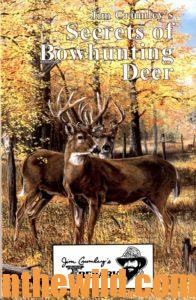 To learn more about hunting deer, go to John E. Phillips’ book, “How to Take Big Buck Deer on Small Properties,” available in Kindle, print and Audible at https://www.amazon.com/. For more information about hunting for deer, check out John E. Phillips’ “Jim Crumley’s Secrets of Bowhunting Deer,” now available as of January 1, 2022, in Audible, as well as paperback and Kindle at https://www.amazon.com/. You may have to copy and paste these links into your browser. (When you click on either book, notice on the left where Amazon says you can read 10% of this book for free and hear 10% for free). On the right side of the page and below the offer for a free Audible trial, you can click on Buy the Audible book. To see many of John E. Phillips’ books, go to https://www.amazon.com/John-E.-Phillips/e/B001HP7K6O.
To learn more about hunting deer, go to John E. Phillips’ book, “How to Take Big Buck Deer on Small Properties,” available in Kindle, print and Audible at https://www.amazon.com/. For more information about hunting for deer, check out John E. Phillips’ “Jim Crumley’s Secrets of Bowhunting Deer,” now available as of January 1, 2022, in Audible, as well as paperback and Kindle at https://www.amazon.com/. You may have to copy and paste these links into your browser. (When you click on either book, notice on the left where Amazon says you can read 10% of this book for free and hear 10% for free). On the right side of the page and below the offer for a free Audible trial, you can click on Buy the Audible book. To see many of John E. Phillips’ books, go to https://www.amazon.com/John-E.-Phillips/e/B001HP7K6O.

